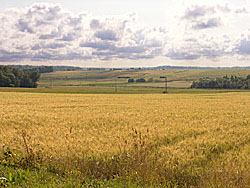Orvydas Farmstead, Sculpture Park
|
Kazimieras Orvydas (1905-1989) and Vilius Orvydas (1952-1992), father and son, their Christian
belief mixed with mysticism and a great deal of screwyness, sorry, artistic freedom, resulted in a very exotic
sculpture park, some sort of public monumentalism, called a monument, an anthem,
an ode to individualism and the human soul . Vilius Orvydas was a true believer
and functioned as spiritual leader to many people. In one place in the park is a lawn where pilgrims came to receive
guidance from him.
If you are only going to see one thing in Zemaitija it must be Orvydas sculpture park outside Salantai, in a place
called Gragzdele, even if Vilius himself in an interview said he didn’t want it to be called a museum. “This is
no museum. It is a spiritual meeting-place,” he said. The whole park breaths of mystique, a mixture of Christian
belief, astrology, and a tinge of paganism. And a lot of other tinges! |
|
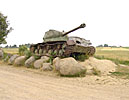
|
At the entrance you are met by the most fearful threat of all, a Russian tank. |
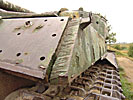
|
At closer inspection you see that it is stuck in the mud, is being grown over, and is broken
down in general. |
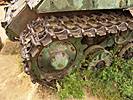
|
Orvydas’ calm belief has changed the threat into something helpless, a symbol of the Soviet
Union that fell apart. |
| Earlier, the tank was standing guard on a concrete plinth at the military cemetery in the middle
of Salantai. Fortunately, it is no longer there. Instead it is slowly decaying in Orvydas’ park. After the fall
of the Soviet Union they didn’t want the tank in the town, but didn’t know where to put it. “Allright, put in out
at my place,” Vilius reportedly said. |
|

|
We’ll start our tour of the park by entering the Gates of Paradise (St. Peter’s Gate, Petrui vartai), very elegantly written in electric welding on the
rectangular, rusty metal sign. |

|
Orvidu herbas, Orvydas’ family coat of arms. |
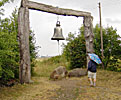
|
There’s a church bell at one place. When we pulled the rope, Perkunas, the God of Thunder,
answered with three thunderclaps. That’s why these images are made in rain. A real photographer doesn’t shun some
rain. |
Works of Special Significance
|
|

|
One of the few women in Orvydas’ works. Very beautiful. |
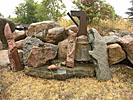
|
Is that a Dalek in the middle? |
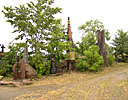
|
A rocket of metal tubes. Maybe. |
|

|
A rotating house. You go into it and turn a wheel. |

|
A free-breaker. It’s obvious that this figure wants to get out of the stone. |

|
If you look closer you see the fantastic art of stonemasonry. |
|
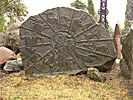
|
The zodiac. |
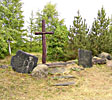
|
The solar system is cut out on the stone tablet to the right. The planets have Our Father cut
into them, in reverse. |
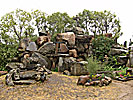
|
Orvydas Hill
of Crosses ? There’s an altar in the middle of it all. |
| There are many stone spirits, tree spirits, suffering trees, sleeping stones, yawning stones
and half finished sculptures everywhere. This series shows but a small selection of all the fantastic, strange,
screwy, half-finished, astrological, mystical... I’m not even trying to arrange everything in the order that you
see it in the park, but rather into categories. Question is, if there is an order. The series ends with a picture
of the stonemasonry workshop. |
|
 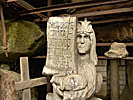        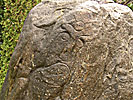 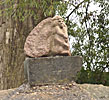 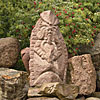 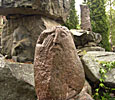 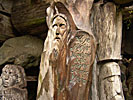 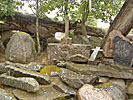 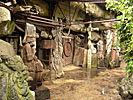
|
Orvydas’ Christian Belief and a Strange Intervention by Michail Gorbachev
|
| Vilius Orvydas opposed the Soviet Union and its atheism, and they were quick to take revenge
with continuous harassment. The park was condemned as unhealthy and unstable and the artists were remanded to dismantle
it. Several tons of stones were removed and Orvydas was accused of stealing “Soviet property” (i.e. the stones).
Soon enough the locals gave him new stones. |
|
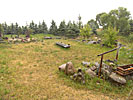
|
Very often pilgrims would come to Vilius, and this is the meadow where he preached. |
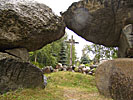
|
It is perhaps obvious that this is Golgatha? |

|
It seems like the road to salvation is up! |
| A documentary was made in 1992, the same year that Vilius died, showing president Michail Gorbachev
visiting one day. He asked Vilius: “What crime are you guilty of, that makes them so nasty?” The answer was: “I
believe in God”. After that the authorities’ pressure decreased somewhat. |
|
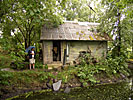
|
In the middle of all the, well, masses of sculptures, we find Orvydas’ residence. |
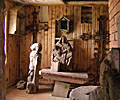
|
It is completely dark inside, but a few long exposures show, in turn, the altar... |
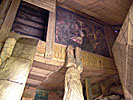
|
..the stairs to the sleeping loft and its decoration, a drinking scene... |
|

|
A look through the door. |
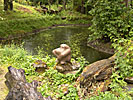
|
At the river bank outside sits a strange, huddling man. |
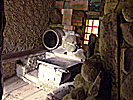
|
and the eating chamber below. |
Lack of Maintenance
|
|
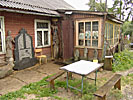
|
Here, in this ordinary house, lives the sister Palmira Orvydaite-Beniusiene. |
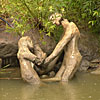
|
A lot is broken in the park. The failing economy makes maintenance difficult. I want to show
the sisters’ sign with an appeal... |

|
for contributions from all good-hearted people, to get money for an alarm system, maintenance
of broken sculptures, a café and some huts for visiting artists. |
Orvydas’ family graves at Salantai cemetery
|
|
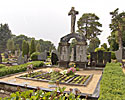
|
At Salantai cemetery in Gargzdele (not the military cemetery) both Kazimeras and Vilius Orvydas
are buried in a grave they cut themselves. It is without names or dates of death. |
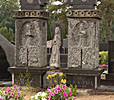
|
Kazimeras died in 1989 and the son in 1992, in the last trembling moments of Communism. The
symbol of Lithuania is inlaid on the grave in black marble. |

|
Their grandparents lie close by. That grave was cut by Orvydas, too. |
